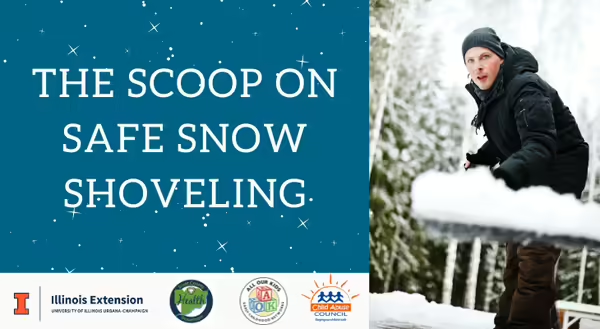
There are an estimated 11,500 snow shovel-related injuries and medical emergencies a year. Two local experts provide safe snow shoveling tips to keep you safe and pain-free.
“As residents of the Midwest, we understand weather can be subject to change in the blink of an eye. When heading out for snow removal, check for icy conditions underneath the snow. This can prevent slips and falls that could lead to unplanned injuries and expensive emergency room visits,” says Justin Rumpza, PT, DPT.
Proper form can help prevent injury. Justin share’s 3 tips on snow shoveling technique:
- Decrease the amount of snow you are lifting in each load. Make sure the shovel is not too short for you, and feels comfortable to use.
- Adjustments to your form that will help reduce risk of injury- lift with your legs, not your back. Decrease twisting when throwing the snow.
- A split stance is a powerful stance to use when shoveling and can protect the lower back.
Pre-Shoveling Warm-Up Exercises provided by Justin (printable PDF with reps/sets)
In combination, this is a quick, well-rounded way to warm up before shoveling. If you feel you don’t have the time to get through all of these exercises, pick a few to warm your body up before going to work on that fresh powder. This can significantly reduce the risk of muscle strain!
- Sidelying Open Book Thoracic Lumbar Rotation and Extension- This is a great mobility exercise to help loosen up that stiff back after a long night of stationary rest.
- Romanian Deadlift- This exercise focuses on activation of those glutes, the big butt muscles that are the largest muscle in your body and can take on the challenge of shoveling snow.
- Mini Squat with Counter Support- Another great exercise to warm up those big quadriceps muscles on the other side of your legs. Remember you’re lifting with your legs today, not your back.
- Jumping Jacks- I know, you haven’t done these since junior high gym class, but they remain a great way to get the blood flowing through the body.
Prevent aches and pains with these 3 takeaways from Dr. Cheryl True:
- Keeping active rather than being sedentary in the following days can reduce muscle soreness. Gentle exercise such as walking or stretching can warm and stretch sore muscles and increase blood flow to those areas. Applying ice to especially sore spots can reduce inflammation. Apply ice to those areas for 20 min intervals over the first 24-48 hours, then alternate with heat. Usually after a couple of days you will start to feel better.
- Using OTC pain relievers (if they are safe for you) may be helpful. A warm bath with Epsom salts can also relax tight muscles.
- Staying well hydrated and eating a healthy diet can be helpful for recovery after shoveling. Protein-rich foods and complex carbohydrates are essential for muscle repair.
Injuries do happen, so be prepared to seek medical advice if you’re faced with these scenarios.
- If you have chest pain, shortness of breath or other worrisome symptoms for heart disease that develop while shoveling, stop and seek care immediately. The combination of physical exertion and cold air can trigger a heart attack in at-risk individuals.
- If you've had a fall or have areas of injury that have unusual or unexpected pain or swelling that isn't improving or worsens, call your primary care physician for advice, or a musculoskeletal specialist for treatment in reducing and managing your symptoms.
Sources:
- Justin Rumpza, PT, DPT, ORA Orthopedics, Moline, IL.
- Dr. Cheryl True, MD, DipABLM, FACLM, True Lifestyle Medicine Clinic, Davenport, IA.